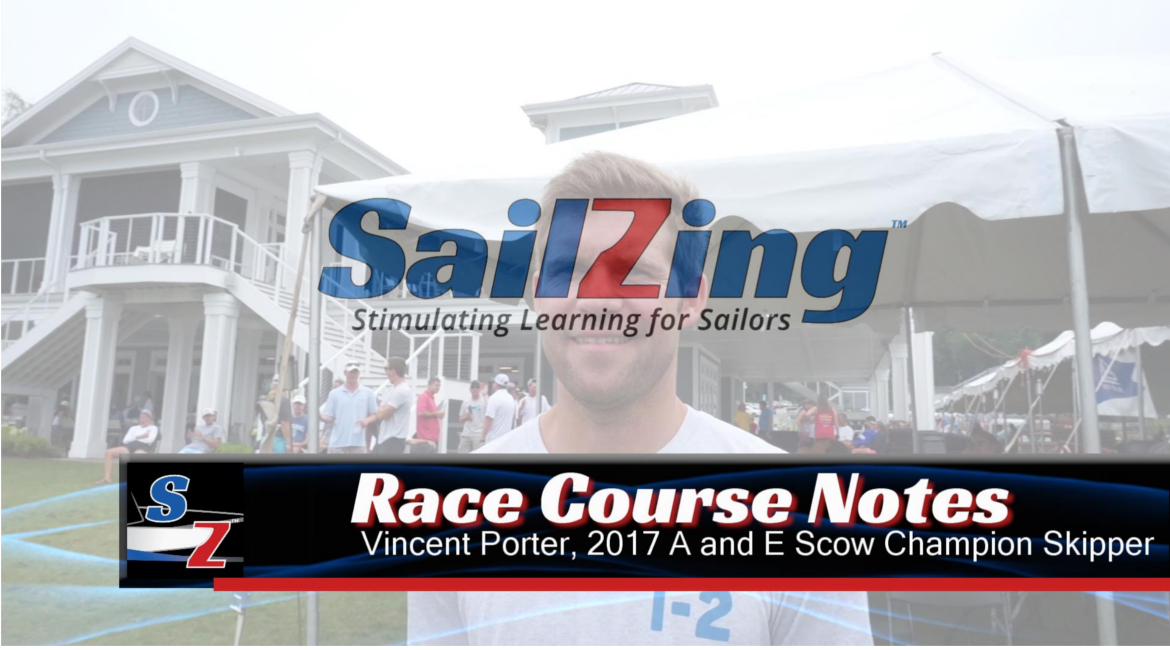Is it true that on some lakes in most conditions, you have to pick a side, rather than play the middle ? SailZing asked some top sailors to discuss their lake sailing strategy at the MC Southeast Regional Regatta at Lake Eustis Sailing Club.
Our “expert panel” included:
- Rob Seidelmann, Cooper River Yacht Club – perennial MC champion
- Jeremy Pape, Lake Lanier Sailing Club – top level sailor in many classes
- Jim Gluek, Melges Performance Sailboats – top level sailor in C, E, and MC scows
- Dave Helmick, Lake Eustis Sailing Club – top sailor and local Eustis expert
Expert Panel Says: Pick a Side
The panel was unanimous that most of the time on lakes, including on Lake Eustis, you have to pick a side. Rob Seidelmann has won more MC events at Eustis than anyone. He says: “Absolutely – in lake sailing, you have to play the edges to have a chance of winning.”
Click on the image to see the 3-1/2 minute video discussion. Here are some of the key points:
- Being conservative and avoiding the edges might prevent a really bad race, but you probably won’t be in contention for the top spots.
- You don’t have to go all the way to an edge – just get to the advantage.
- Get to the race course early and see if you can determine the favored side. Gary Jobson discusses how to do this in Right or Left? How to Choose the Faster Side from Sailing World.
- Before the start and during the race, keep an eye on the competition and go where the top sailors are going if it looks right.
- Don’t forget about other key strategy rules, such as sailing in clear air, more breeze, and on the lifted tack. Use these to help get you to the favored side.
- Your appetite for risk may change during the regatta depending on your standings and nearest competitors.
Why Work the Edges in Lake Sailing ?
Rob’s comment about working the edges in lake sailing needs further review. You don’t read much about this in the sailing literature. What is it about lakes that results in one side being favored, even without classic persistent shifts, light air, or shore effects? At SailZing, we’re trying to fill this knowledge gap.
One Key: Length of Legs vs. Frequency of Wind Changes
We picked this up from Get to the Advantaged Side of the Course, by Stuart Walker in Sailing World. His insight is that “medium-length” courses don’t see enough changes in the wind for the effects to average out. Therefore, one side is always to going to work out better. Our study of the wind, especially surges and rolls may explain this further.
Surges
We learned about surges in The Spectrum of the Wind. Surges are areas of more wind that range in size from 500-2,000 meters. Surges exist on most of our race courses, but they are random and move slowly. A typical 1/2 to 1 mile leg on a lake course might see only one surge, and not everyone will get it. A longer leg might see several surges that have a better chance of averaging out.
Rolls
“Roll” is weather talk for the repeating changes in wind direction and strength caused by larger scale “waves” in the turbulent layer. See The Spectrum of the Wind for more. Rolls affect most of the course when they occur, but their period in light to medium air can be as long as 12 minutes or more. In a 15 minute leg, in light to medium air, you might see one or two changes in wind direction and speed. If you’re on the favorable side of the roll, your competitors on the other side may not get a chance to recover.
What are Your Insights?
We don’t think that “pick a side” is always the answer, even for lake sailing. We think there is more to learn about this topic. Send us your insights or some leads for us to follow, and we’ll discuss this again in a future post.
Related Content:
Pre-Race Routine: Get a Leg up on the Competition
Sailors Helping Sailors
Will you share your knowledge with your related Comments below?






Got a comment from Henry Chesnutt, who asked us to seek out Bill Colburn’s opinion on picking a side. Bill is a multiple ILYA MC champion. Here is Bill’s response:
I watched what they said, and guess I would respond that there are other mindsets that work too. You mention “other key strategy rules, such as sailing in clear air, more breeze, and on the lifted tack.” Those three “strategy rules” are most important to me, and if they take me to one side of the course that is fine, but I never pick a side. My plan is this: to get a good start, stay in clear air, stay in strong air, stay in phase with the shifts, and go as fast as possible.